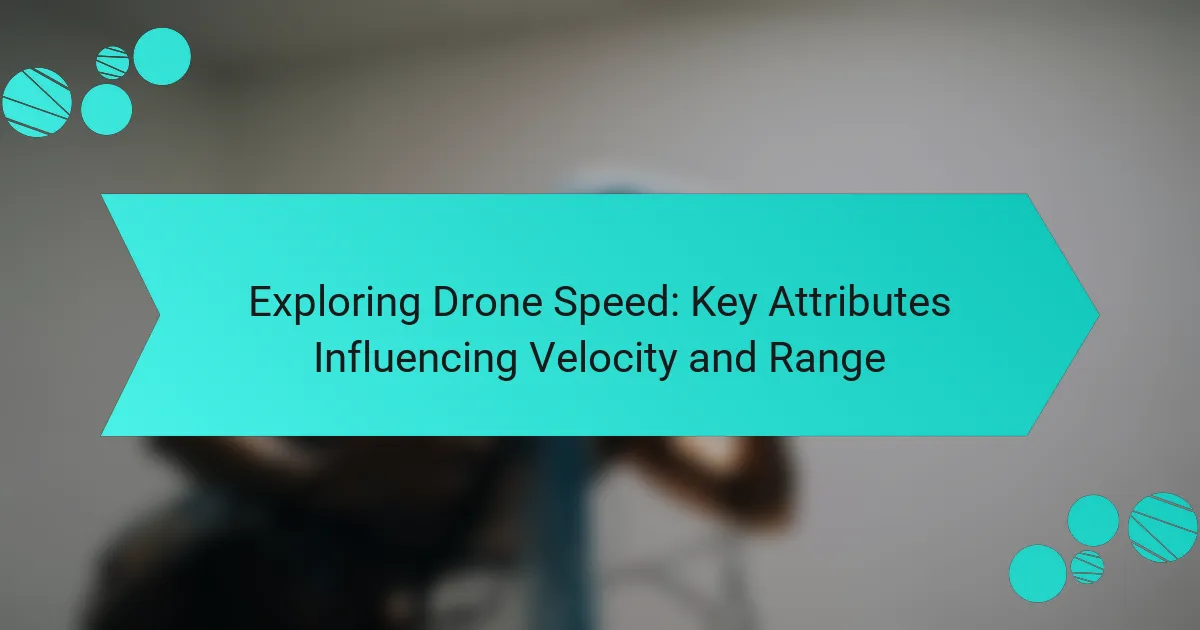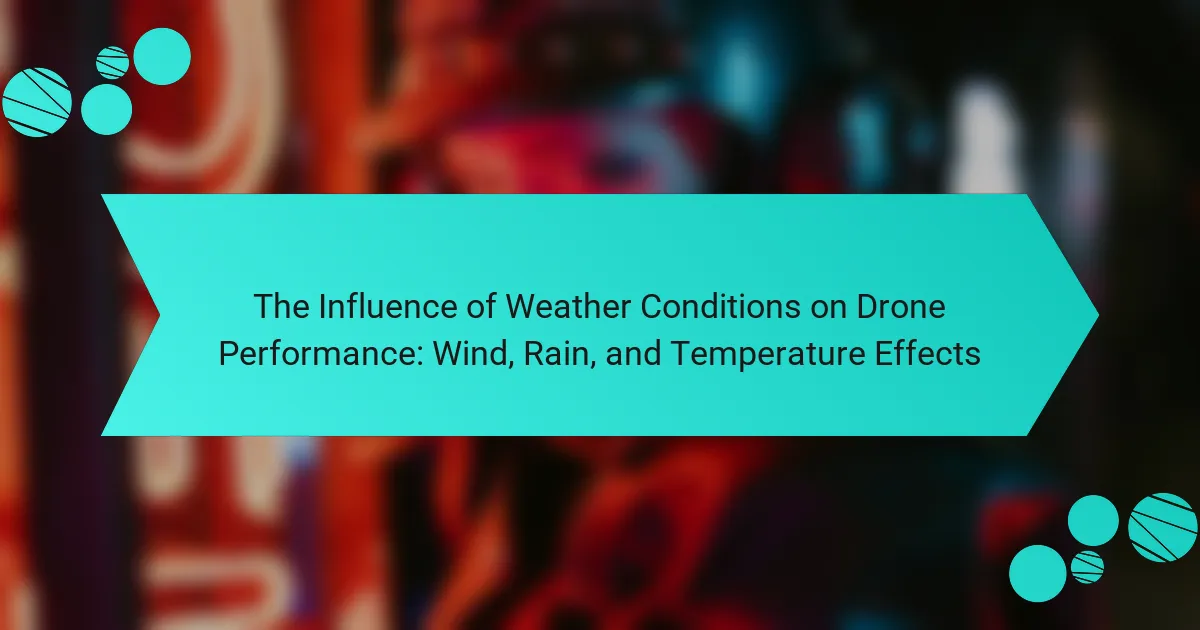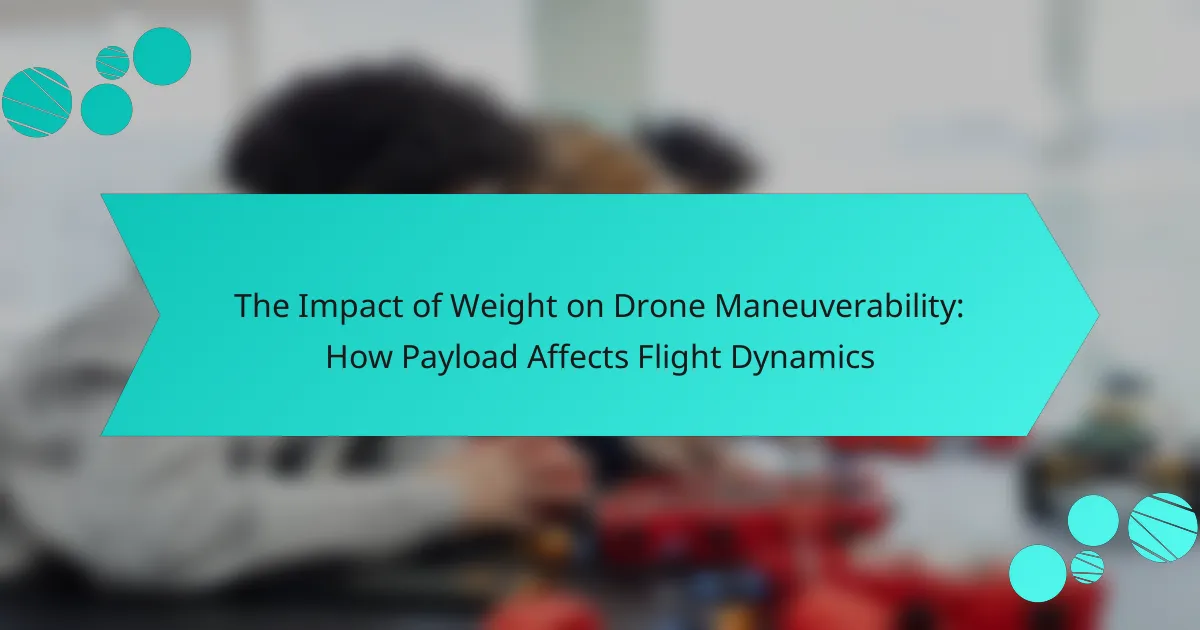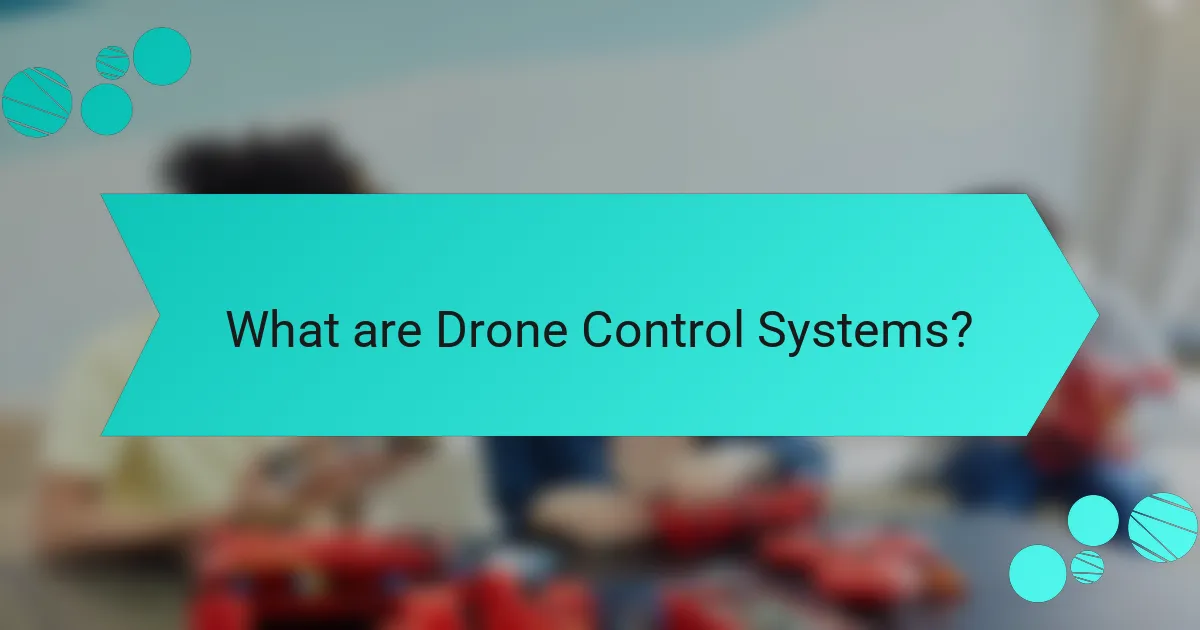
What are Drone Control Systems?
Drone control systems are the technologies and methods used to operate and manage drones. These systems enable remote operation, allowing users to control drones from a distance. They utilize various components, including hardware and software, to facilitate flight operations. Control systems can include manual controls, automated flight paths, and real-time data processing.
Many drones use GPS for navigation, providing precise location data. Sensors are integrated to enhance stability and safety during flight. Advanced systems may incorporate artificial intelligence for autonomous decision-making. These technologies are crucial for applications such as aerial photography, surveying, and delivery services. The effectiveness of drone control systems is supported by ongoing advancements in technology and increased accessibility to drone hardware.
How do Drone Control Systems function?
Drone control systems function by integrating hardware and software to manage the flight of unmanned aerial vehicles (UAVs). They utilize a combination of sensors, processors, and communication systems to ensure stable flight and navigation. The flight controller acts as the brain, processing data from various sensors such as gyroscopes and accelerometers. These sensors provide real-time information about the drone’s orientation and position.
Control inputs are received from the pilot via a remote control or pre-programmed flight plans. The system interprets these inputs and adjusts the drone’s motors accordingly. This allows for precise maneuvers and stability during flight. Additionally, GPS modules provide location data, enabling autonomous navigation and waypoint tracking.
Drone control systems also employ fail-safe mechanisms to ensure safety. For instance, if communication is lost, the drone can return to its launch point automatically. This functionality is critical for preventing accidents and ensuring reliable operation. Overall, drone control systems are designed to facilitate both remote operation and autonomous flight, making them versatile tools in various applications.
What are the key components of Drone Control Systems?
The key components of Drone Control Systems include the flight controller, communication system, sensors, and power system. The flight controller is the brain of the drone, processing inputs from the pilot and sensors to maintain stability and control. The communication system allows for data exchange between the drone and the operator, typically using radio frequencies. Sensors, such as GPS and accelerometers, provide critical data for navigation and position tracking. The power system includes batteries that supply energy to the drone, determining its flight time and range. Each of these components plays a vital role in ensuring the drone operates effectively and safely.
How do these components interact to control drones?
Drones are controlled through the interaction of several key components, including the flight controller, sensors, and communication systems. The flight controller processes data from sensors to determine the drone’s position and orientation. Sensors, such as accelerometers and gyroscopes, provide real-time feedback on movement and stability. Communication systems relay commands from the operator to the drone and send telemetry data back to the operator. These components work together to execute flight commands accurately. For example, when a user inputs a command via a remote controller, the flight controller interprets this command and adjusts the drone’s motors accordingly. This interaction ensures stable flight and precise maneuvering.
What types of Drone Control Systems exist?
There are three main types of drone control systems: remote control, autonomous, and semi-autonomous systems. Remote control systems rely on a human operator to control the drone in real-time. This type of system typically uses radio signals for communication. Autonomous systems operate independently, using onboard sensors and algorithms to navigate and perform tasks without human intervention. These systems often utilize GPS and computer vision technologies. Semi-autonomous systems combine elements of both, allowing for some level of human control while also enabling the drone to perform specific tasks autonomously. Each type of system serves different applications in various industries, including agriculture, surveillance, and delivery services.
What distinguishes remote operation from autonomous systems?
Remote operation involves a human operator controlling a system from a distance. In contrast, autonomous systems function independently without human intervention. Remote operation requires real-time input from the operator to execute tasks. Autonomous systems use pre-programmed algorithms to make decisions based on sensor data. Remote operation is dependent on communication links for control. Autonomous systems rely on onboard processing to navigate and perform tasks. The distinction lies in the level of human involvement and decision-making autonomy.
How do different systems impact drone performance?
Different systems significantly impact drone performance through their influence on control, stability, and operational efficiency. Control systems determine how a drone responds to pilot inputs and environmental factors. For example, advanced flight control algorithms enhance stability in turbulent conditions. Navigation systems, such as GPS and inertial measurement units, affect positioning accuracy and route planning. Autonomy systems enable drones to perform tasks without human intervention, improving efficiency and safety. Research shows that drones equipped with superior navigation systems can reduce flight times by 20%. Overall, the integration of these systems dictates a drone’s capability to operate effectively in various environments.
What are the primary applications of Drone Control Systems?
Drone Control Systems are primarily used in various applications including aerial photography, agriculture, surveillance, and logistics. Aerial photography enables capturing high-resolution images for media and real estate. In agriculture, drones facilitate crop monitoring and precision farming, improving yield and resource management. Surveillance applications utilize drones for security and monitoring large areas efficiently. Logistics applications involve the delivery of goods, enhancing supply chain efficiency. These diverse applications demonstrate the versatility and importance of Drone Control Systems across multiple industries.
How are Drone Control Systems utilized in various industries?
Drone control systems are utilized across various industries for efficient operations. In agriculture, they monitor crop health and optimize resource use. In construction, drones conduct site surveys and monitor progress. In logistics, they facilitate package delivery and inventory management. In environmental monitoring, drones collect data on wildlife and pollution levels. In public safety, they assist in search and rescue missions. In filmmaking, drones capture aerial footage and enhance storytelling. These applications demonstrate the versatility and effectiveness of drone control systems in diverse sectors.
What specific tasks can drones perform using these systems?
Drones can perform various tasks using control systems that enable remote operation, autonomy, and navigation. These tasks include aerial photography and videography, which capture high-resolution images for media and surveying. Drones are also used in agriculture for crop monitoring and precision farming. They can deliver packages, enhancing logistics and supply chain efficiency. Search and rescue operations benefit from drones for locating missing persons in difficult terrains. Infrastructure inspection is another task, allowing for the assessment of bridges, power lines, and pipelines. Additionally, drones assist in environmental monitoring by collecting data on wildlife and ecosystems. These capabilities are supported by advancements in navigation technologies, such as GPS and computer vision, which enhance the precision and reliability of drone operations.
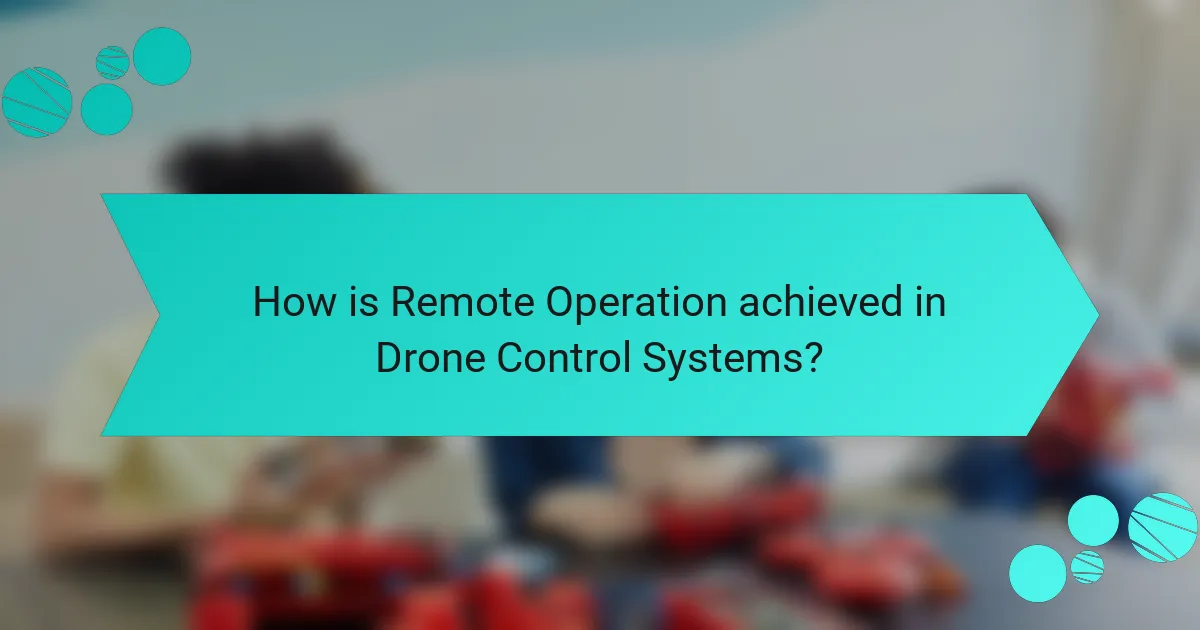
How is Remote Operation achieved in Drone Control Systems?
Remote operation in drone control systems is achieved through a combination of wireless communication and control algorithms. These systems utilize radio frequency (RF) signals to transmit commands from a ground control station to the drone. The drone’s onboard receiver interprets these commands and executes them in real-time.
Additionally, GPS technology provides location data, allowing the drone to navigate accurately. Control algorithms ensure stability and responsiveness during flight. Many drones also incorporate telemetry systems, which send back data about the drone’s status and environment. This feedback loop enhances situational awareness for the operator.
The effectiveness of remote operation is supported by advancements in communication protocols, such as Wi-Fi and LTE, which increase range and reliability. Furthermore, the integration of fail-safe mechanisms ensures that the drone can return to a safe location if communication is lost. These elements collectively enable efficient and effective remote operation in drone control systems.
What technologies enable remote operation of drones?
Technologies enabling remote operation of drones include radio frequency communication, GPS, and onboard sensors. Radio frequency communication allows operators to send commands and receive data from drones. GPS provides real-time location tracking for navigation. Onboard sensors, such as cameras and LiDAR, assist in obstacle detection and environmental awareness. These technologies work together to ensure safe and effective drone operation. For instance, the integration of GPS and sensors enhances autonomous flight capabilities. This combination allows drones to execute complex missions with minimal human intervention.
How do communication protocols affect remote operation?
Communication protocols are essential for effective remote operation. They define the rules and standards for data exchange between devices. These protocols ensure reliable communication, which is crucial for controlling drones remotely. For instance, protocols like MAVLink enable real-time telemetry and command transmission. They help maintain a stable connection over varying distances. Poor or incompatible protocols can lead to delays or data loss. This can jeopardize the safety and efficiency of remote operations. Additionally, communication protocols influence the latency of control signals. Lower latency improves responsiveness, enhancing operational performance. Thus, robust communication protocols are vital for successful remote drone operation.
What are the limitations of remote operation?
Remote operation has several limitations. One major limitation is latency in communication. This delay can affect real-time decision-making and control. Another limitation is the dependency on stable internet connections. Poor connectivity can disrupt control and data transmission. Additionally, remote operation can be hindered by regulatory restrictions. Different regions have varying laws on drone usage. Environmental factors also pose challenges. Weather conditions can affect visibility and signal strength. Finally, operator fatigue can impact performance. Long hours of monitoring can lead to decreased attention and reaction times.
What are the challenges of remote operation in different environments?
Remote operation in different environments faces several challenges. Communication issues arise due to signal interference or distance. Environmental factors like weather can impact visibility and operational safety. Terrain variations can hinder navigation and stability. Regulatory constraints may limit operational capabilities in certain areas. Technical limitations of drones can affect performance in specific conditions. Human factors, such as operator fatigue, can also impact effectiveness. These challenges require careful planning and adaptation to ensure successful remote operations.
How do environmental factors impact remote control effectiveness?
Environmental factors significantly impact remote control effectiveness. Factors such as distance, obstacles, and interference can hinder signal transmission. For example, physical barriers like buildings and trees can obstruct the line of sight. Weather conditions, including rain and snow, can also disrupt signals. Additionally, electromagnetic interference from other devices can degrade performance. Studies indicate that effective range decreases in adverse conditions. Research shows that drones may lose connectivity beyond a certain distance in urban environments. Thus, understanding these factors is crucial for optimizing remote control systems.
What solutions exist to overcome these challenges?
Solutions to overcome challenges in drone control systems include enhanced communication protocols and improved sensor technologies. Enhanced communication protocols ensure reliable data transmission between the drone and the operator. This reduces latency and increases control accuracy. Improved sensor technologies provide better environmental awareness. These sensors include LiDAR and computer vision systems. They help drones navigate complex environments more effectively. Additionally, implementing machine learning algorithms can optimize autonomous decision-making. These algorithms allow drones to adapt to changing conditions in real-time. Regular software updates and maintenance also play a crucial role in addressing operational challenges. By ensuring systems are up-to-date, vulnerabilities can be minimized. Overall, these solutions contribute to more efficient and reliable drone operations.
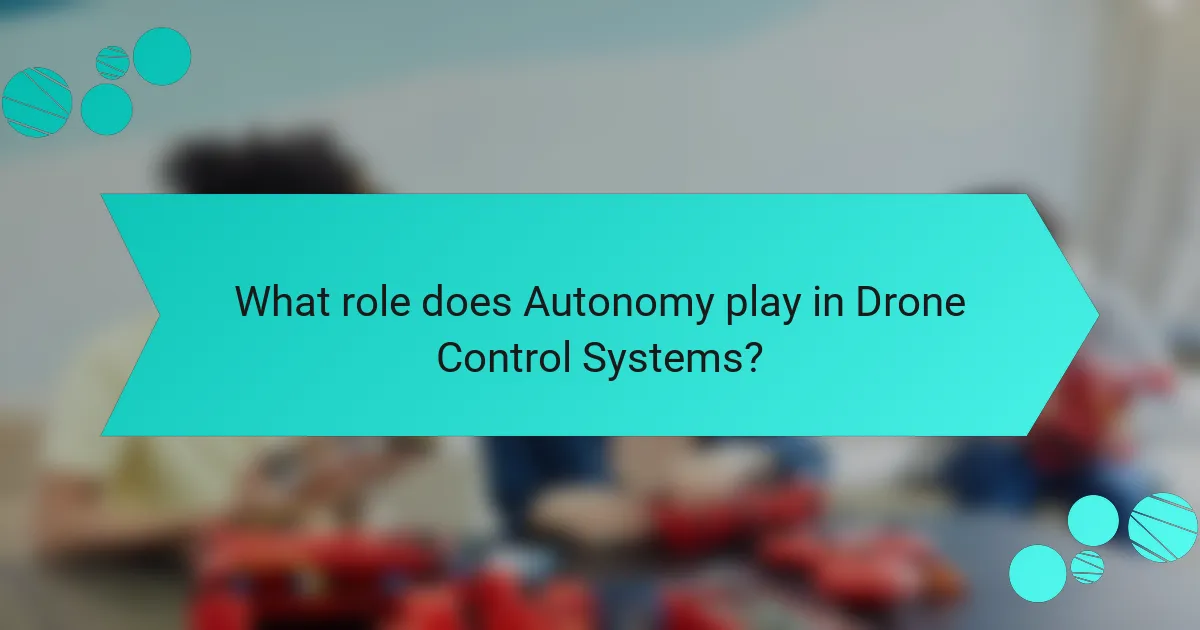
What role does Autonomy play in Drone Control Systems?
Autonomy in drone control systems enables drones to operate independently without constant human intervention. This capability enhances efficiency in various applications, including surveillance, delivery, and agricultural monitoring. Autonomous drones can navigate complex environments using sensors and algorithms for obstacle avoidance. They can perform pre-programmed missions and adapt to changing conditions in real-time. Research indicates that autonomy significantly reduces the workload on human operators, allowing for more effective mission management. A study by the National Institute of Standards and Technology highlights that autonomous systems improve operational safety by minimizing human error. Overall, autonomy is essential for maximizing the potential of drone technology in diverse fields.
How do autonomous drones navigate without human intervention?
Autonomous drones navigate without human intervention using a combination of sensors, algorithms, and pre-programmed flight paths. These drones rely on GPS for location tracking and navigation. They use onboard sensors like cameras, LiDAR, and ultrasonic sensors to detect obstacles. Advanced algorithms process this data to make real-time navigational decisions. Machine learning models can improve obstacle avoidance and route optimization. Autonomous drones can also follow predefined missions stored in their systems. This allows them to operate independently in various environments. The integration of these technologies enables safe and efficient navigation.
What technologies support autonomous navigation?
Technologies that support autonomous navigation include GPS, LiDAR, computer vision, and inertial measurement units (IMUs). GPS provides location data for outdoor navigation. LiDAR uses laser scanning to create detailed 3D maps of the environment. Computer vision processes images from cameras to identify obstacles and navigate effectively. IMUs track motion and orientation, aiding in stabilization and navigation. These technologies work together to enhance the autonomy and reliability of navigation systems in drones and other vehicles.
How do sensors contribute to drone autonomy?
Sensors enhance drone autonomy by providing critical data for navigation and decision-making. They enable drones to perceive their environment and adjust their actions accordingly. For example, GPS sensors allow for precise location tracking. Cameras and LiDAR sensors help in obstacle detection and avoidance. Inertial measurement units (IMUs) provide information on orientation and movement. These sensors work together to create a comprehensive situational awareness. This data is processed in real-time, allowing drones to make autonomous flight decisions. Research shows that sensor fusion improves navigation accuracy by up to 30%. Thus, sensors are essential for enabling safe and efficient drone operations.
What are the benefits of using autonomous drones?
Autonomous drones offer numerous benefits, including increased efficiency and reduced operational costs. They can perform tasks such as surveying, mapping, and monitoring with minimal human intervention. This leads to faster data collection and analysis. Autonomous drones enhance safety by reducing risks to human operators in hazardous environments. They can access hard-to-reach areas, performing inspections and deliveries where traditional methods may fail. Additionally, they operate consistently and accurately, minimizing human error. Studies show that autonomous drones can reduce project time by up to 50%. This efficiency translates to significant cost savings for businesses.
How does autonomy enhance operational efficiency?
Autonomy enhances operational efficiency by enabling drones to perform tasks without constant human intervention. This capability reduces the need for real-time control, allowing for faster response times. Autonomous drones can execute predefined missions with precision, minimizing errors associated with manual operation. They can also operate in environments that are hazardous or inaccessible to humans, increasing safety and productivity. According to a study by the Association for Unmanned Vehicle Systems International, autonomous systems can improve task completion rates by up to 50%. This increase in efficiency leads to lower operational costs and better resource allocation. Overall, autonomy streamlines workflows and optimizes performance in various applications.
What safety considerations are associated with autonomous drones?
Autonomous drones pose several safety considerations. First, they must avoid collisions with obstacles or other aircraft. This requires advanced sensors and algorithms for real-time navigation. Next, there is the risk of loss of control due to signal interference or system failure. Such incidents can lead to crashes or unintended landings. Additionally, autonomous drones must comply with airspace regulations to ensure safe operations. Unauthorized flights can endanger people and property. Privacy concerns also arise, as drones equipped with cameras may infringe on individuals’ rights. Furthermore, cybersecurity threats can compromise drone systems, leading to potential misuse. These considerations highlight the importance of rigorous testing and regulatory measures in the development of autonomous drone technology.
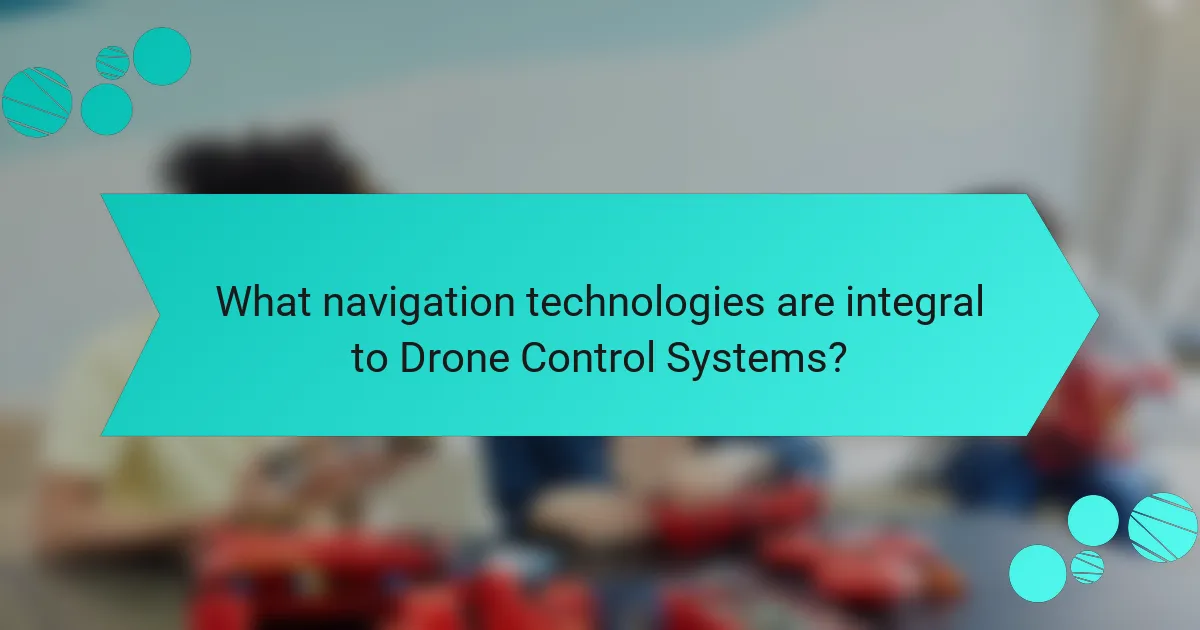
What navigation technologies are integral to Drone Control Systems?
Global Positioning System (GPS) is integral to drone control systems. GPS provides precise location data for navigation. It enables drones to determine their position in real-time. Inertial Measurement Units (IMUs) are also crucial. IMUs track the drone’s orientation and acceleration. They help maintain stability during flight. Computer vision technology aids in obstacle detection. Drones can navigate complex environments using visual data. Additionally, LiDAR sensors are used for mapping and terrain analysis. These sensors create detailed 3D representations of the surroundings. Altogether, these technologies ensure safe and efficient drone operation.
What types of navigation systems are used in drones?
Drones utilize several types of navigation systems. The primary navigation systems include GPS, inertial navigation systems (INS), and visual-based navigation. GPS provides location data using satellites, enabling precise positioning. Inertial navigation systems use accelerometers and gyroscopes to track movement and orientation. Visual-based navigation employs cameras and computer vision to identify landmarks and obstacles. Other systems may include ultrasonic and lidar for distance measurement. Each navigation system contributes to the drone’s ability to operate effectively in various environments.
How does GPS technology facilitate drone navigation?
GPS technology facilitates drone navigation by providing precise location data. Drones utilize GPS signals to determine their position in real-time. This information allows drones to navigate accurately along predetermined flight paths. GPS enables drones to maintain stable altitude and orientation during flight. It also assists in obstacle avoidance by mapping the surrounding environment. Many drones use GPS for geofencing, which restricts their flight to designated areas. The accuracy of GPS can be within a few meters, enhancing overall navigation reliability. Additionally, GPS data supports automated return-to-home functions in case of signal loss.
What are the advantages of using inertial navigation systems?
Inertial navigation systems (INS) offer several advantages for navigation and control. They provide high accuracy in position and velocity estimation. INS operates independently of external references, making it reliable in GPS-denied environments. The systems can quickly respond to changes in motion, enhancing real-time navigation capabilities. They are compact and can be integrated into various platforms, including drones. Additionally, INS can function in harsh conditions, such as underwater or in space. Their continuous operation without the need for signal reception is a significant benefit. Overall, inertial navigation systems improve the reliability and efficiency of navigation in diverse applications.
How do navigation technologies improve drone performance?
Navigation technologies enhance drone performance by providing precise positioning and route optimization. These technologies include GPS, inertial measurement units (IMUs), and computer vision systems. GPS allows drones to determine their location with high accuracy, enabling efficient flight paths. IMUs complement GPS by tracking the drone’s orientation and acceleration, ensuring stability during flight. Computer vision systems help drones navigate complex environments by recognizing obstacles and adjusting flight paths in real-time.
Studies show that drones equipped with advanced navigation technologies can reduce flight time by up to 30%. Additionally, improved navigation increases safety by minimizing the risk of collisions. Enhanced navigation capabilities also allow for autonomous operations, expanding the potential applications of drones in industries such as agriculture, logistics, and surveillance.
What role does real-time data play in navigation accuracy?
Real-time data enhances navigation accuracy by providing up-to-the-minute information on a drone’s environment. This data includes weather conditions, obstacles, and GPS coordinates. With real-time updates, drones can adjust their flight paths dynamically. This adaptability minimizes the risk of collisions and improves route optimization. Studies show that drones using real-time data can reduce navigation errors by up to 30%. Additionally, real-time data integration allows for more precise positioning, enhancing overall operational efficiency.
How can navigation systems be integrated for enhanced functionality?
Navigation systems can be integrated for enhanced functionality by combining GPS, inertial measurement units (IMUs), and computer vision. GPS provides real-time location data for outdoor navigation. IMUs measure acceleration and rotation, which helps maintain stability and orientation. Computer vision uses cameras to detect obstacles and recognize landmarks.
Integrating these technologies allows for improved accuracy in positioning. A study by S. M. M. A. Alshahrani et al. in “IEEE Access” highlights that sensor fusion from these systems reduces errors in navigation data. This integration enhances autonomous decision-making capabilities in drones. It also enables better obstacle avoidance and path planning, making drones more efficient in complex environments.
What best practices should be followed for effective drone operation?
Effective drone operation requires adherence to specific best practices. First, operators must familiarize themselves with local regulations and airspace restrictions. This ensures compliance with laws governing drone use. Second, conducting pre-flight checks is essential. This includes verifying battery levels, GPS functionality, and camera equipment. Third, maintaining line of sight with the drone during operation is crucial. It enhances control and situational awareness. Fourth, operators should avoid flying in adverse weather conditions. Wind, rain, and low visibility can compromise safety. Fifth, using a reliable and updated software system improves navigation accuracy. Regular updates can prevent technical failures. Finally, practicing emergency procedures prepares operators for unexpected situations. These best practices contribute to safe and effective drone operation.
Drone control systems are the technologies and methods that facilitate the operation and management of drones, encompassing remote operation, autonomy, and navigation technologies. This article provides a comprehensive overview of how these systems function, including key components such as flight controllers, communication systems, and sensors. It explores different types of control systems—remote, autonomous, and semi-autonomous—and their applications across various industries, including agriculture, surveillance, and logistics. Additionally, the article addresses the challenges and solutions associated with remote operation and the role of navigation technologies in enhancing drone performance.
